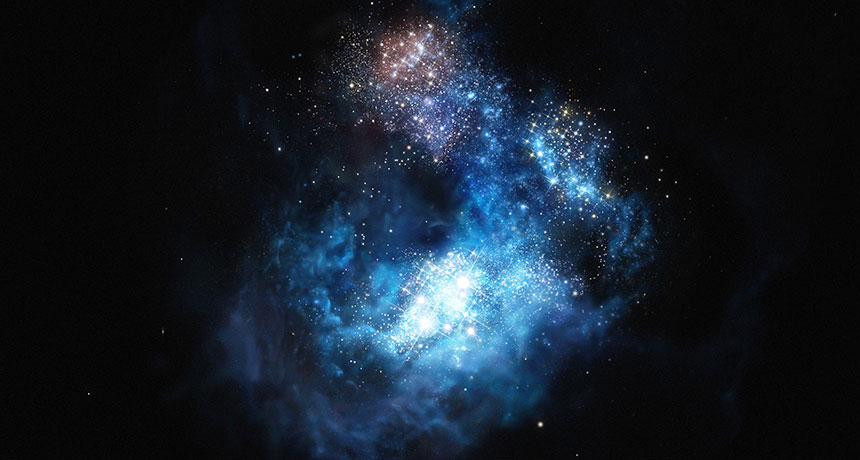A new, nonexplosive source of black holes?
New computer program suggests at least one black hole formed from a collapsing gas cloud

Galaxy CR7, in this artist’s illustration, is unusual. It may have a rare kind of black hole — one that formed from the collapse of a gas cloud.
M. Kornmesser/ESO
Black holes usually form from the violent death of a star. But that might not be the only way, a new study finds. It points to a remote galaxy that may harbor a black hole made instead from the collapse of a massive cloud of gas. This rarity might even explain how some galaxies built gargantuan black holes in the first billion years or so after the Big Bang.
The galaxy, called CR7, is unusual. It blasts out more ultraviolet light than other galaxies that lived at the same time. That was roughly 13 billion years ago, a mere 800 million years after the Big Bang. The gas in CR7 also appears to lack elements such as carbon and oxygen. These elements are forged within stars and then ejected into space.
One explanation for the large output of ultraviolet light and lack of heavier elements such as carbon in this galaxy: It is giving birth to first-generation stars. These stars would be similar to the first stars ever created in the universe. That means they would be made of only hydrogen, helium and very small amounts of lithium.
Another hypothesis is that CR7 harbors the first known black hole to form when a blob of interstellar gas collapsed under its own weight. This would have happened without first creating stars.
A black hole is the more likely explanation. At least, that’s what Aaron Smith and his colleagues now say. Smith is an astronomer at the University of Texas at Austin. In a new study, he was part of a team that developed a computer program to test that idea.
The computer simulates the conditions that likely would have been present. Then it lets gravity, energy and other forces in the universe predict — or model — how they should have played out over time.
That computer model focused on interstellar gas, which is the gas between stars. It predicted how the gas would have interacted with harsh radiation from primordial stars or a large black hole.
Light emitted from a collection of hot, young stars can’t explain one odd feature of CR7, this analysis found. There’s a parcel of gas racing away from the galaxy. How speedily? Try 580,000 kilometers per hour (some 360,000 miles per hour). That’s fast, although not record fast. Radiation from a superheated disk of debris, swirling around a black hole, can push the gas that fast, though. To do this, the researchers estimate the black hole must be roughly 100,000 times as massive as our sun!
They report their analyses in the August 11 Monthly Notices of the Royal Astronomical Society.
Nothing certain yet
There is no evidence yet that CR7 has a black hole. But if the galaxy does have one, it would be the first evidence of a black hole forming out of clouds that haven’t given birth to stars yet.
Such a discovery could help astronomers sort out a major issue about how some of the earliest supermassive black holes in the universe formed. For instance, how could they be created in about 1 billion years out of only smaller black holes merging together? “There’s just not enough time to do that,” Smith says. A black hole that formed from the direct collapse of gas, however, creates a massive seed all in one go. It could jump-start the growth of a behemoth black hole that would eventually weigh as much as several billion suns.
“This is definitely a good step forward,” says David Sobral. He is an astrophysicist at Lancaster University in England. He discovered CR7 last year. But it’s too early to say whether a black hole or a group of stars powers this black hole, he says. “I’ve tried to stay a bit away from it and argue that what we need is new observations instead of taking sides.”
With the data that are available, it’s hard to distinguish between stars or a black hole, Sobral says. That’s why he and his colleagues have reserved time with the Hubble Space Telescope in January. They are also awaiting new data from the Atacama Large Millimeter/submillimeter Array in Chile. Data from both observatories will help researchers look for traces of heavy elements in CR7.
To astronomers, a “heavy element” is any atom heavier than helium (which is number 2 on the periodic table). If the data still show no sign of heavy atoms such as carbon, then CR7 probably hosts a nest of first-generation stars. A black hole, on the other hand, probably would have formed long enough ago that there would be enough time for stars to form. Those stars, Sobral says, would would form heavier elements. And then a smidgen of such elements would pollute CR7.
A growing census of similar galaxies will help as well. “We’re now finding that CR7 is not alone,” Sobral says. He and colleagues have since found four other galaxies comparable to CR7 in the early universe. The team presented its results June 27 at the National Astronomy Meeting in Nottingham, England. “We don’t have to discuss one single thing,” he says. It’s now possible, he says, to “put [CR7] into a broader picture.”







